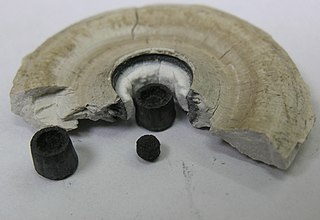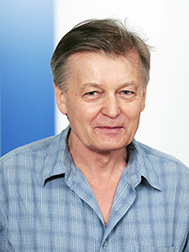Related Research Articles

Superconductivity is a set of physical properties observed in certain materials where electrical resistance vanishes and magnetic fields are expelled from the material. Any material exhibiting these properties is a superconductor. Unlike an ordinary metallic conductor, whose resistance decreases gradually as its temperature is lowered, even down to near absolute zero, a superconductor has a characteristic critical temperature below which the resistance drops abruptly to zero. An electric current through a loop of superconducting wire can persist indefinitely with no power source.
Unconventional superconductors are materials that display superconductivity which does not conform to conventional BCS theory or its extensions.

High-temperature superconductors are defined as materials with critical temperature above 77 K, the boiling point of liquid nitrogen. They are only "high-temperature" relative to previously known superconductors, which function at even colder temperatures, close to absolute zero. The "high temperatures" are still far below ambient, and therefore require cooling. The first breakthrough of high-temperature superconductor was discovered in 1986 by IBM researchers Georg Bednorz and K. Alex Müller. Although the critical temperature is around 35.1 K, this new type of superconductor was readily modified by Ching-Wu Chu to make the first high-temperature superconductor with critical temperature 93 K. Bednorz and Müller were awarded the Nobel Prize in Physics in 1987 "for their important break-through in the discovery of superconductivity in ceramic materials". Most high-Tc materials are type-II superconductors.
Metallic hydrogen is a phase of hydrogen in which it behaves like an electrical conductor. This phase was predicted in 1935 on theoretical grounds by Eugene Wigner and Hillard Bell Huntington.
Palladium hydride is palladium metal with hydrogen within its crystal lattice. Despite its name, it is not an ionic hydride but rather an alloy of palladium with metallic hydrogen that can be written PdHx. At room temperature, palladium hydrides may contain two crystalline phases, α and β. Pure α-phase exists at x < 0.017 while pure β-phase exists at x > 0.58; intermediate x values correspond to α-β mixtures.
The Schön scandal concerns German physicist Jan Hendrik Schön who briefly rose to prominence after a series of apparently successful experiments with semiconductors that were discovered later to be fraudulent. Before he was exposed, Schön had received the Otto-Klung-Weberbank Prize for Physics and the Braunschweig Prize in 2001, as well as the Outstanding Young Investigator Award of the Materials Research Society in 2002, all of which were later rescinded.
A room-temperature superconductor is a hypothetical material capable of displaying superconductivity above 0 °C, operating temperatures which are commonly encountered in everyday settings. As of 2023, the material with the highest accepted superconducting temperature was highly pressurized lanthanum decahydride, whose transition temperature is approximately 250 K (−23 °C) at 200 GPa.
Superconductors can be classified in accordance with several criteria that depend on physical properties, current understanding, and the expense of cooling them or their material.

Covalent superconductors are superconducting materials where the atoms are linked by covalent bonds. The first such material was boron-doped synthetic diamond grown by the high-pressure high-temperature (HPHT) method. The discovery had no practical importance, but surprised most scientists as superconductivity had not been observed in covalent semiconductors, including diamond and silicon.
In condensed matter physics, the resonating valence bond theory (RVB) is a theoretical model that attempts to describe high-temperature superconductivity, and in particular the superconductivity in cuprate compounds. It was first proposed by an American physicist P. W. Anderson and Indian theoretical physicist Ganapathy Baskaran in 1987. The theory states that in copper oxide lattices, electrons from neighboring copper atoms interact to form a valence bond, which locks them in place. However, with doping, these electrons can act as mobile Cooper pairs and are able to superconduct. Anderson observed in his 1987 paper that the origins of superconductivity in doped cuprates was in the Mott insulator nature of crystalline copper oxide. RVB builds on the Hubbard and t-J models used in the study of strongly correlated materials.

Distrontium ruthenate, also known as strontium ruthenate, is an oxide of strontium and ruthenium with the chemical formula Sr2RuO4. It was the first reported perovskite superconductor that did not contain copper. Strontium ruthenate is structurally very similar to the high-temperature cuprate superconductors, and in particular, is almost identical to the lanthanum doped superconductor (La, Sr)2CuO4. However, the transition temperature for the superconducting phase transition is 0.93 K (about 1.5 K for the best sample), which is much lower than the corresponding value for cuprates.

Mikhail Ivanovich Eremets is an experimentalist in high pressure physics, chemistry and materials science. He is particularly known for his research on superconductivity, having discovered the highest critical temperature of 250 K (-23 °C) for superconductivity in lanthanum hydride under high pressures. Part of his research contains exotic manifestations of materials such as conductive hydrogen, polymeric nitrogen and transparent sodium.
A polyhydride or superhydride is a compound that contains an abnormally large amount of hydrogen. This can be described as high hydrogen stoichiometry. Examples include iron pentahydride FeH5, LiH6, and LiH7. By contrast, the more well known lithium hydride only has one hydrogen atom.
In solid-state physics, the kagome metal or kagome magnet is a type of ferromagnetic quantum material. The atomic lattice in a kagome magnet has layered overlapping triangles and large hexagonal voids, akin to the kagome pattern in traditional Japanese basket-weaving. This geometry induces a flat electronic band structure with Dirac crossings, in which the low-energy electron dynamics correlate strongly.
Lanthanum decahydride is a polyhydride or superhydride compound of lanthanum and hydrogen (LaH10) that has shown evidence of being a high-temperature superconductor. It was the first metal superhydride to be theoretically predicted, synthesized, and experimentally confirmed to superconduct at near room-temperatures. It has a superconducting transition temperature TC around 250 K (−23 °C; −10 °F) at a pressure of 150 gigapascals (22×106 psi), and its synthesis required pressures above approximately 160 gigapascals (23×106 psi).
In chemistry, a hydridonitride is a chemical compound that contains both hydride and nitride ions. These inorganic compounds are distinct from inorganic amides and imides as the hydrogen does not share a bond with nitrogen, and usually contain a larger proportion of metals.
Uranium ditelluride is an inorganic compound with the formula UTe2. It was discovered to be an unconventional superconductor in 2018.
Ranga P. Dias is a researcher and academic who specializes in condensed matter physics. He is an assistant professor in the departments of Mechanical Engineering and Physics and Astronomy at the University of Rochester (UR), and a scientist at the UR Laboratory for Laser Energetics.

LK-99, also called PCPOSOS, is a gray–black, polycrystalline compound, identified as a copper-doped lead‒oxyapatite. A team from Korea University led by Lee Sukbae (이석배) and Kim Ji-Hoon (김지훈) began studying this material as a potential superconductor starting in 1999. In July 2023, they published preprints claiming that it acts as a room-temperature superconductor at temperatures of up to 400 K at ambient pressure.
References
- 1 2 3 4 5 6 7 8 9 Snider, Elliot; Dasenbrock-Gammon, Nathan; McBride, Raymond; Debessai, Mathew; Vindana, Hiranya; Vencatasamy, Kevin; Lawler, Keith V.; Salamat, Ashkan; Dias, Ranga P. (15 October 2020). "RETRACTED ARTICLE: Room-temperature superconductivity in a carbonaceous sulfur hydride". Nature. 586 (7829): 373–377. Bibcode:2020Natur.586..373S. doi:10.1038/s41586-020-2801-z. OSTI 1673473. PMID 33057222. S2CID 222823227. (Retracted, see doi:10.1038/s41586-022-05294-9, PMID 36163290)
- 1 2 "Material sets superconducting record". Chemical & Engineering News. Retrieved 2020-10-17.
- 1 2 "Breakthrough or bust? Claim of room-temperature superconductivity draws fire" . Retrieved 2021-10-26.
- 1 2 Hirsch, J. E.; Marsiglio, F. (August 2021). "Unusual width of the superconducting transition in a hydride". Nature. 596 (7873): E9–E10. arXiv: 2010.10307 . Bibcode:2021Natur.596E...9H. doi:10.1038/s41586-021-03595-z. ISSN 1476-4687. PMID 34433940. S2CID 237306217.
- 1 2 Eremets, M. I.; Minkov, V. S.; Drozdov, A. P.; Kong, P. P.; Ksenofontov, V.; Shylin, S. I.; Bud’ko, S. L.; Prozorov, R.; Balakirev, F. F.; Sun, Dan; Mozaffari, S. (2022-03-25). "High-Temperature Superconductivity in Hydrides: Experimental Evidence and Details". Journal of Superconductivity and Novel Magnetism. 35 (4): 965–977. arXiv: 2201.05137 . doi: 10.1007/s10948-022-06148-1 . ISSN 1557-1939. S2CID 245906117.
- 1 2 Hirsch, J. E. (2021-09-26). "On the ac magnetic susceptibility of a room temperature superconductor: anatomy of a probable scientific fraud". Physica C: Superconductivity and Its Applications: 1353964. arXiv: 2110.12854 . doi:10.1016/j.physc.2021.1353964. ISSN 0921-4534. S2CID 239194714.
- 1 2 Dogan, Mehmet; Cohen, Marvin L. (2021-04-15). "Anomalous behavior in high-pressure carbonaceous sulfur hydride". Physica C: Superconductivity and Its Applications. 583: 1353851. arXiv: 2012.10771 . Bibcode:2021PhyC..58353851D. doi:10.1016/j.physc.2021.1353851. ISSN 0921-4534. S2CID 229340504.
- 1 2 Castelvecchi, Davide (2022-09-27). "Stunning room-temperature-superconductor claim is retracted". Nature. doi:10.1038/d41586-022-03066-z. PMID 36171305. S2CID 252597663.
- 1 2 Dasenbrock-Gammon, Nathan; Snider, Elliot; McBride, Raymond; Pasan, Hiranya; Durkee, Dylan; Khalvashi-Sutter, Nugzari; Munasinghe, Sasanka; Dissanayake, Sachith E.; Lawler, Keith V.; Salamat, Ashkan; Dias, Ranga P. (March 2023). "RETRACTED ARTICLE: Evidence of near-ambient superconductivity in a N-doped lutetium hydride". Nature. 615 (7951): 244–250. Bibcode:2023Natur.615..244D. doi:10.1038/s41586-023-05742-0. ISSN 1476-4687. PMID 36890373. (Retracted, see doi:10.1038/s41586-023-06774-2, PMID 37935926)
- 1 2 Wood, Charlie (14 October 2020). "Room-Temperature Superconductivity Achieved for the First Time". Quanta Magazine. Retrieved 2020-10-16.
- ↑ Gubler, Moritz; Flores-Livas, José A.; Kozhevnikov, Anton; Goedecker, Stefan (2022-01-06). "Missing theoretical evidence for conventional room-temperature superconductivity in low-enthalpy structures of carbonaceous sulfur hydrides". Physical Review Materials. 6 (1): 014801. arXiv: 2109.10019 . Bibcode:2022PhRvM...6a4801G. doi:10.1103/PhysRevMaterials.6.014801. ISSN 2475-9953. S2CID 237581517.
- ↑ Cartlidge, Edwin (2015). "Superconductivity record sparks wave of follow-up physics". Nature. 524 (7565): 277. Bibcode:2015Natur.524..277C. doi: 10.1038/nature.2015.18191 . PMID 26289188. S2CID 2294273.
- ↑ Eric Hand (26 September 2022). "'Something is seriously wrong': Room-temperature superconductivity study retracted". Science.
After doubts grew, blockbuster Nature paper is withdrawn over objections of study team
- ↑ Snider, Elliot; Dasenbrock-Gammon, Nathan; McBride, Raymond; Debessai, Mathew; Vindana, Hiranya; Vencatasamy, Kevin; Lawler, Keith V.; Salamat, Ashkan; Dias, Ranga P. (2022). "Retraction Note: Room-temperature superconductivity in a carbonaceous sulfur hydride". Nature. 610 (7933): 804. Bibcode:2022Natur.610..804S. doi: 10.1038/s41586-022-05294-9 . PMID 36163290. S2CID 252544156.
- ↑ Johnston, Hamish (14 October 2020). "Superconductivity endures to 15 °C in high-pressure material". Physics World. Retrieved 15 October 2020.
- 1 2 Rincon, Paul (2020-10-15). "Superconductors: Material raises hope of energy revolution". BBC News. Retrieved 2020-10-16.
- 1 2 Service, Robert F. (2020-10-16). "At last, room temperature superconductivity achieved". Science. 370 (6514): 273–274. Bibcode:2020Sci...370..273S. doi:10.1126/science.370.6514.273. ISSN 0036-8075. PMID 33060340. S2CID 222841128.
- ↑ Castelvecchi, Davide (15 October 2020). "First room-temperature superconductor excites — and baffles — scientists". Nature. 586 (7829): 349. Bibcode:2020Natur.586..349C. doi:10.1038/d41586-020-02895-0. PMID 33057238. S2CID 222838731.
- ↑ Conover, Emily (2020-10-14). "The first room-temperature superconductor has finally been found". Science News. Retrieved 2020-10-16.
- ↑ Delbert, Caroline (2020-10-15). "In a Monumental First, Scientists Discover a Room-Temperature Superconductor". Popular Mechanics. Retrieved 2020-10-16.
- ↑ Chang, Kenneth (2020-10-14). "Finally, the First Room-Temperature Superconductor". The New York Times. ISSN 0362-4331 . Retrieved 2020-10-16.
- ↑ Rochester, University of (2020-10-14). ""Holy Grail" Sought for More Than a Century: Researchers Synthesize Room Temperature Superconducting Material". SciTechDaily. Retrieved 2020-10-16.
- ↑ van der Marel, D.; Hirsch, J. E. (2022). "Room-temperature superconductivity – or not ? Comment on Nature 586, 373 (2020) by E. Snider et al". International Journal of Modern Physics B. 37 (4): 2375001. arXiv: 2201.07686 . doi:10.1142/S0217979223750012. S2CID 252324362.
- ↑ Caren, Rachel (2023-07-23). "Professor faces second paper retraction due to alleged data manipulation". Campus Times. Retrieved 2024-04-02.
- ↑ "Retraction Watch database: Dias, Ranga P". Retraction Watch. Retrieved 2024-04-01.